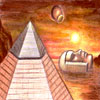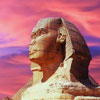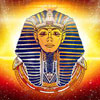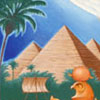Egypt: Traditions of Antiquity
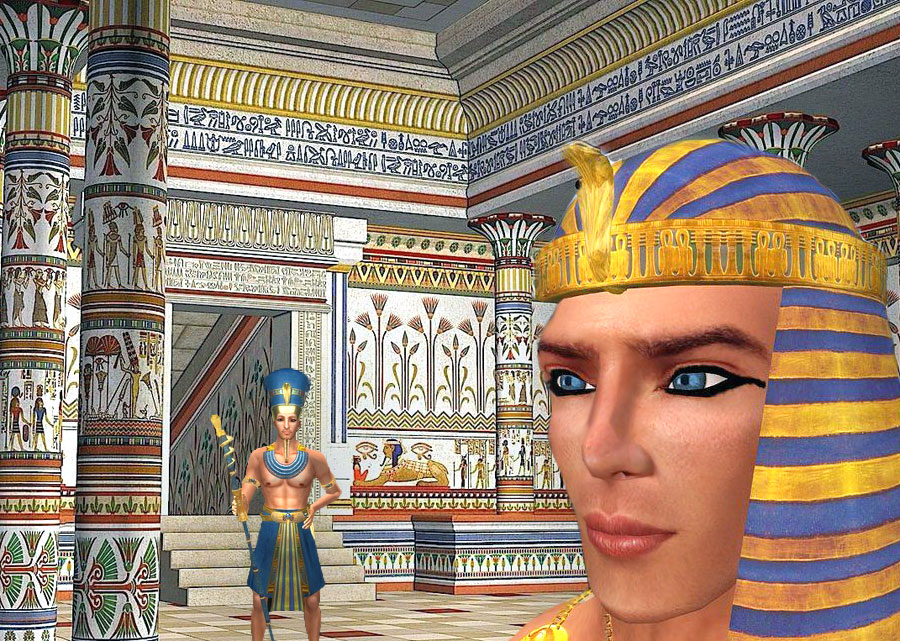 by M.G. Hawking
by M.G. Hawking
“Every man takes the limits of his own field of vision for the limits of the world.” –Arthur Schopenhauer
Historians once credited the civilizations that emerged in the Tigris-Euphrates region as among the earliest known non-nomadic agrarian societies. Because the civilizations of Sumer, Ubaid, Akkad, Assyria and Babylon all emerged around the Tigris-Euphrates, the theory that Mesopotamia was the cradle of civilization was once widely accepted. Current archaeological assessments hold that there was no single “cradle” of civilization, but that several civilizations developed independently, among them the Near Eastern Neolithic (Mesopotamia). Recent findings indicate that Egypt developed far earlier than the Tigris-Euphrates cultures and rapidly flowered into a civilization specifically and uniquely its own; one of the richest and grandest, one of the most powerful and yet one of the most graceful cultures in history. By Egypt’s side Sumer’s culture was but a crude beginning, not even Greece or Rome would surpass it, far less our own.
“The art of Egypt was so far advanced that it is surprising to find any scholar of early culture proposing that the crude contemporary art of the early Babylonians is the product of a civilization earlier than that of the Nile. There is but little room for doubt that Egypt led the way in the creation of the earliest known group of civilizations.” –James Henry Breasted, renowned archaeologist and Egyptologist
The voluminous lore of the ancient Brahmaic and Egyptian traditions relates that in the antediluvian time of zp tpj (generally transcribed as Zep Tepi), the “first occasion” or “first time,” mysterious, highly enlightened “gods” appeared in Egypt, bearing previously unknown technology and knowledge. The texts inscribed on the walls of the Temple of Edfu in Upper Egypt contain explicit descriptions of the time of Zep Tepi and the coming of the “bringers of knowledge,” recounting their arrival in a “cosmic egg radiating colored light,” bearing the “gods” who brought the gift of civilization to Egypt, the primary of which was Ptah, whose rule, the texts tell us, began circa 18,000 B.C.
It’s important to note that the Egyptian tradition of Zep Tepi, in both its symbolism and historical time frame, bears a striking resemblance to references found in the ancient B’on theogony of the Qinghai-Tibet Plateau. Those relate that, as early as 18,000 to 16,000 B.C., an entity referred to as “Gekhoe” appeared to become “king of the gods” of the ancient Zhang Zhung culture, having arrived from the “heavens” before the dawn of civilization. The B’on theogony recounts how this occurred: From the emptiness of space a “resplendent jeweled egg” descended to earth through the agency of “Iha of bright light.” Then, while “radiating brilliant hues on father mountain and mother lake,” the resplendent jeweled egg opened. From this magical egg arose Gekhoe, who became the sovereign “god” of the realm, at which time “in the sky there appeared brilliant lights, melodious sounds in space, and many other wonderful occurrences.”
Plato (c. 428-348 B.C.) writes that Egyptian priests kept records of their history going back over eighteen-thousand years: “Egypt has recorded and kept eternally the wisdom of the ancient ages . . . all coming from time immemorial when gods governed the earth in the dawn of civilization.”
Plato was very well acquainted with the Egypt of his time. One of Taylor’s manuscripts contains the following remarkable paragraph: “Plato was initiated into the ‘Greater Mysteries’ at the age of 49. The initiation took place in one of the subterranean halls of the Great Pyramid in Egypt. The Isiac Table formed the altar, before which Plato stood and received that which was always his, but which the ceremony of the Mysteries enkindled and brought from its dormant state. With this ascent, after three days in the Great Hall, he was received by the Hierophant of the Pyramid (the Hierophant was seen only by those who had passed the three days, the three degrees, the three dimensions) and given verbally the Highest Esoteric Teachings, each accompanied with Its appropriate Symbol. After a further three months’ sojourn in the halls of the Pyramid, the Initiate Plato was sent out into the world to do the work of the Great order, as Pythagoras and Orpheus had been before him.” –Thomas Taylor (A.D. 1758-1835), the first to translate into English the complete works of Aristotle and of Plato, as well as the Orphic fragments.
Herodotus, “The Father of History” (484-425 B.C.), tells us that when Hecataeus of Miletus (550-476 B.C.) boasted to the Egyptian priests that he could trace his ancestry through fifteen centuries to a god, they quietly showed him, in a hidden sanctuary deep under the sands, the statues of three-hundred-forty-five generations since their “gods” had appeared in the Nile valley, marking an historical record extending back some one-hundred-eighty centuries, to approximately 18,000 B.C.
An ancient papyrus found at Luxor (Thebes), now known as the ‘Turin Royal Canon’ or the ‘Turin King List,’ is of special interest. The discoverer of the papyrus was likely a local resident who found it in a tomb or temple near Thebes. Bernardino Drovetti, then French Consul-General of Egypt, later acquired the papyrus, but just how is uncertain, as accounts disagree.
This ancient hieratic papyrus is heralded by modern scholars as the most extensive list ever found of Egyptian Kings as compiled by the ancient Egyptian scholars themselves. The front (recto) side of the papyrus mentions certain domains of Ramesses II, suggesting that it was produced during his reign (circa 1279-1213 B.C.). The ‘Royal Canon of Turin,’ unlike the other king lists of the New Kingdom, was clearly produced not for any religious or political purpose, but instead as a complete and historically accurate chronological reference guide. There is no evidence of any intentional exclusion or suppression of kings, as the contemporary and ephemeral kings are included, even the reviled foreign kings of the Second Intermediate Period. The papyrus is currently housed in the Museo Egizio (Egyptian Museum) at Turin, Italy. The papyrus 1874 verso is approximately 175 centimeters wide, and 42 centimeters tall (68 inches by 16 inches).
The list in the ‘Royal Canon of Turin’ formulates the basis for most of the chronology that predates the reign of Ramesses II. The ‘Turin King List’ relates that—long before the “land of the Pharaohs” was ruled by “mortals”–beings who had come from “the heavens” were the first to arrive and reign over the region of the Nile. In the papyrus, these mysterious beings are referred to as “Gods” and “Demigods.” The final two lines of Column One of the list, titled “Gods of Ancient Egypt,” reads: “Venerables Shemsu-Hor, 13,420 years; Reign before the Shemsu-Hor, 23,200 years.” Pause for amazement.
Who were these mysterious “gods”? Could the time-frames of such astonishing antiquity expressed in these ancient records, hieroglyphic temple texts and wisdom traditions be accurate?
In the Sahara Desert of southern Egypt, west of Aswan, is an area known as Nabta Playa. Here an ancient stone calendar circle, along with 25 or more other megalithic erections and structures, was identified by archaeologist Fred Wendorf and his team in 1998. An initial radiocarbon dating of extant cultural artifacts indicated a most recent habitation date of roughly 10,000 B.C. According to an extensive analysis by NASA astrophysicist Thomas Brophy, Ph.D., and his team, three stones inside the Nabta calendar circle represent the belt of Orion, just as the three pyramids of Giza align to represent the constellation of Orion as it appeared circa 12,500 B.C., something we find with the great Mayan pyramids as well. The stones of Nabta Playa’s stone calendar circle and the corresponding stars in the sky aligned on summer solstice nights as they appeared circa 16,500 B.C. Based on these and other analyses of monoliths in the area, Brophy concludes that the early inhabitants of Nabta Playa possessed highly sophisticated astronomical knowledge, the type of knowledge we associate with advanced technology and civilization.
It should be noted that the ancient Egyptian and ancient Mesoamerican civilizations such as the Maya were parallel in a great many ways, despite being located on opposite sides of the Atlantic Ocean. Both cultures’ creation stories held that their gods came from the stars, both had advanced astronomical knowledge, both built pyramids, both used solar symbolism, both believed in life after death, preparing their dead for a journey to the afterlife via an elaborate ceremony, and so on and so on. Interestingly, ancient Egyptian symbols have been found in Mesoamerican ruins, such as the Ankh, the Egyptian hieroglyphic character that read as “life” and represented the concept of eternal being beyond death.
The dates of the structures at Nabta Playa are well in line with the dating of the oldest sections of the Great Sphinx. Geological and seismic analyses, utilizing the weathering and erosion patterns correlated with the paleoclimatology and subsurface features, establish that the earliest portions of the Great Sphinx and the walls of the Sphinx enclosure date back to the period of 11,000 to 10,000 B.C., and perhaps far earlier. The precise alignment of the pyramids at Giza and the stones of the megalithic calendar circle at Nabta Playa indicate that the constellation of Orion—which represented the god Osiris during pre-dynastic times—was of prime importance.
Nearly all the ancients agreed in ascribing the invention of the sciences to the Egyptians. Like almost everything else in the cultural life of ancient Egypt, it drips with evidence of its unknown and mysterious origins. Clement of Alexandria (A.D. 150-215) gives us the titles of four Egyptian astronomy books (which have not survived): a) On the Disposition of Fixed Stars and Stellar Phenomena, b) On the Disposition of the Sun, Moon and Planets, c) On the Syzergies and Phases of the Sun and Moon, d) On Risings. For century after century they kept track of the position and movements of the planets, until their records stretched back for thousands of years. They distinguished between planets and fixed stars, noted in their catalogues stars of the sixth magnitude (invisible to the unaided eye), and charted what they thought were the astral influences of the heavens on the fortunes of men. From these observations they built the calendar which was to be one of Egypt’s greatest gifts to mankind.
How could the Ancient Egyptians have had such advanced astronomical knowledge in the very infancy of known history? From what source could such advanced knowledge have come?
“Ancient Egypt presents us with an impenetrable mystery. How may we explain a Neolithic desert people spawning the most majestic civilization of history? Their rapid ascension from a primitive state to a previously unapproached zenith of technology and culture demonstrates advancements that utterly elude explanation. Many of their artistic and architectural productions are unequaled to this day. What could possibly explain vast technical knowledge and sophistication appearing so fully-formed so suddenly?” – Legendary Egyptologist Flinders Petrie, Archaeological Journal (1911)
According to their own legends, all their sciences were introduced circa 18,000 B.C. by Thoth, the Egyptian god-of-all-trades, who arrived in the region of the Nile in the time of Zep Tepi. During his three-thousand-year-long reign on earth, the most ancient books in each of the sciences were among the twenty thousand volumes said to have been composed by this mysterious deity. Interestingly, our current knowledge does not permit us to improve upon this theory of the origins of science of Egypt.
Excerpt from Secrets Of The Ancient World
Posted in Other Topics, True History of Manwith comments disabled.


